USPTO UpdateTrademark Public Advisory Committee (TPAC) Quarterly Meeting
Nehal Madhani | February 03, 2022
On January 28, 2022, the USPTO held the Trademark Public Advisory Committee (TPAC) Quarterly Meeting, reviewing policies, goals, performance, budget, and user fees, among other important topics. This article provides a summary of key highlights from the meeting.
USPTO New Applications
The USPTO discussed the continuing surge in trademark application filings. FY 2021 closed out with 944,000 classes filed, a 27.5% increase in filings over 2020. FY 2022 projections indicate that the numbers may drop slightly to 844,000 class filings (down by 9% over 2021 filings). However, realizing that 2021 was an anomaly, the 2022 projections are still a 16% increase over 2020 filings. This reflects historically high filing rates. As of the date of the TPAC Meeting, filings were down 2% over projections.
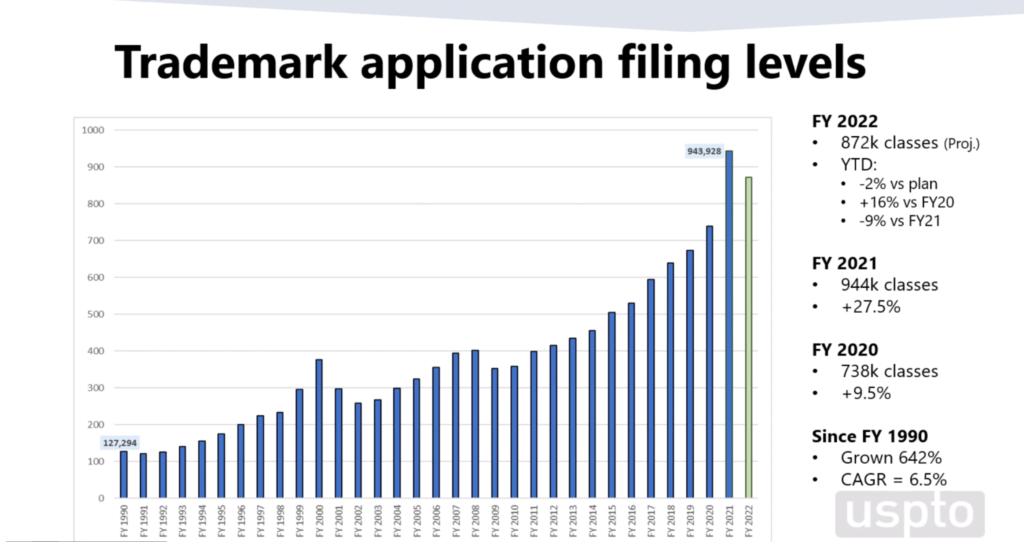
In terms of the nature of the filings and where they are originating, 60% of new USPTO trademark applications are being filed by US-based applicants and this figure is expected to stay the same in FY 2022. Applicants based in China were responsible for 24% of new applications in FY 2021, but the USPTO expects that the number will drop to 18% in FY 2022 while the number of filings from applicants based in the European Union is expected to increase to 12%. Applications from the rest of the world will rise to 10%. The USPTO noted that the United Kingdom has been the greatest contributor to new applications originating in Europe.
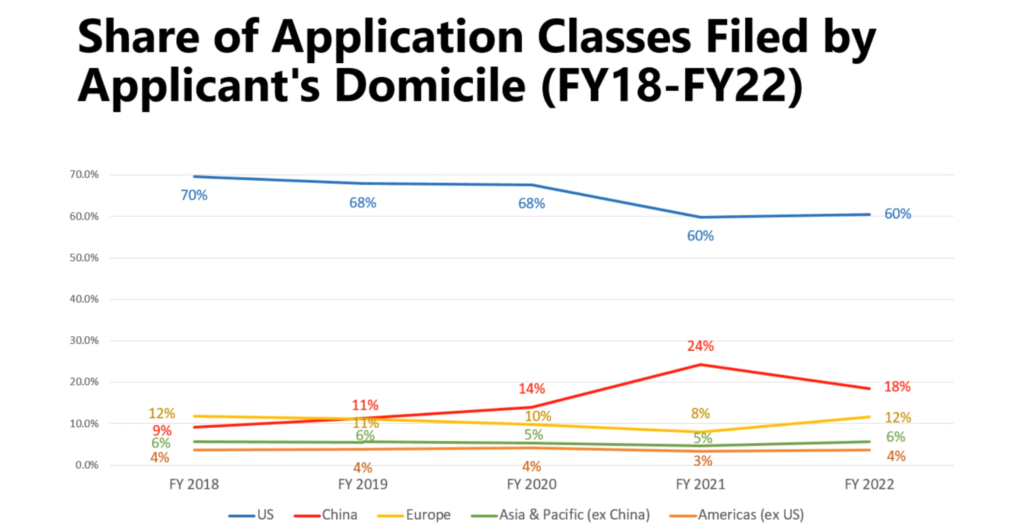
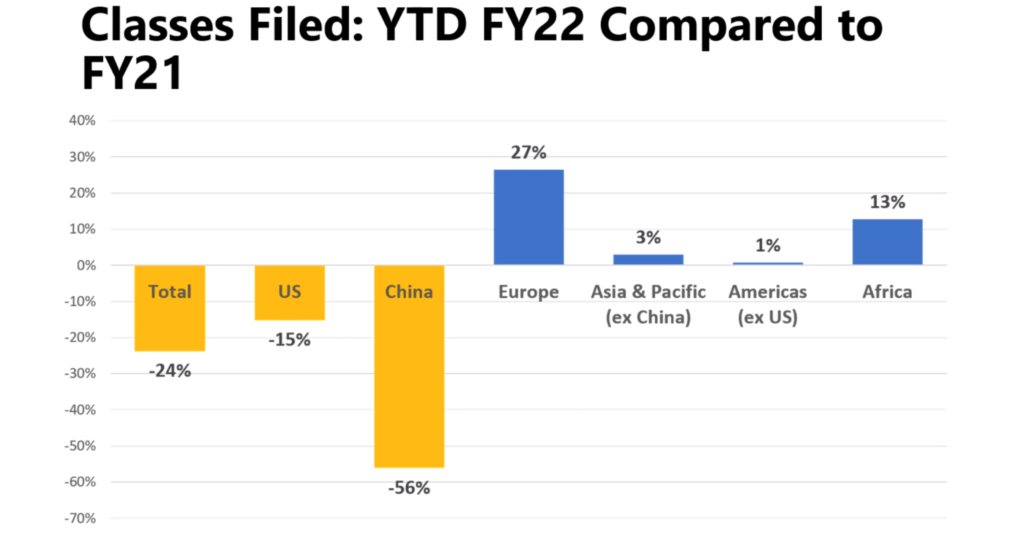
In terms of what type of applicants are filing new trademark applications with the USPTO, around 25% of filings are by pro se applicants. 43% of trademark applications in FY 2020 were filed by small filers, those who have filed between 2-9 applications. Another way to look at it, 76% of newly-filed applications are filed by small filers or one-time filers.
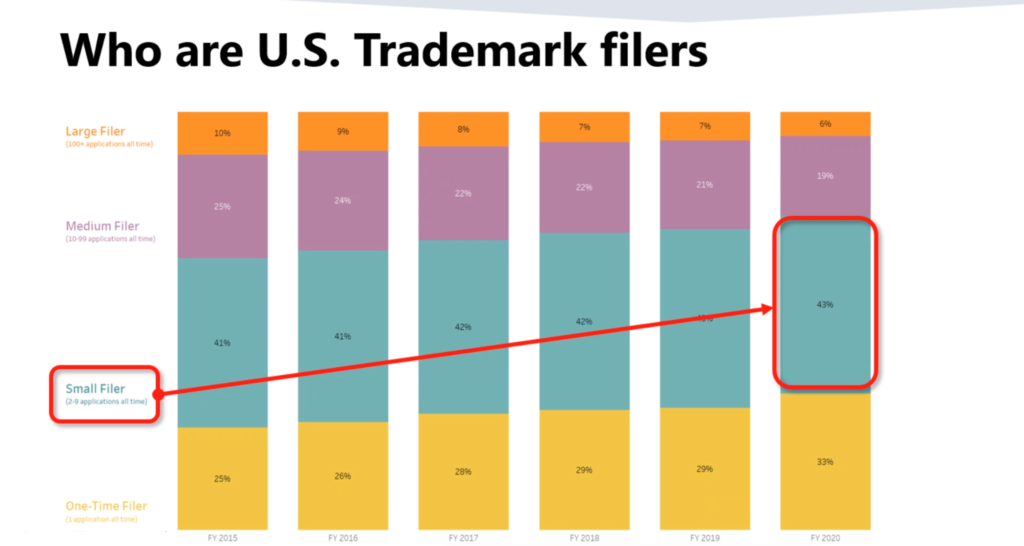
USPTO Management of Applications
The USPTO reported that it is working hard to manage the new filings. The First Action Pendency—the time from when an application is filed to when the first determination is made by the Examining Attorney—is currently over 7.3 months. The upper goal range is 7.5 months and the lower goal range is 2.5 months. The USPTO hopes that incentives will help to bring the length of time down over the course of 2022. However, the USPTO recognized that it may still be difficult to speed up the process while the USPTO is still addressing such a significant backlog of newly-filed applications.

While the USPTO is managing a huge quantity of newly-filed applications, the Office has placed great emphasis on the quality of examinations. In 2020, the USPTO established specific performance measures to assess the quality of trademark examination based on the following factors:
First action compliance rate – the total number of first actions without any substantive decision-making errors made, substantive decision-making errors missed, or substandard refusals under section 2 of the Trademark Act divided by the total number of first actions reviewed.
Final compliance rate – the total number of cases without any substantive decision-making errors divided by the total number of reviewed final actions and cases approved for publication.
Office action excellence – looks to the application’s adherence to registrability standards and the office action itself, including research, writing, legal decision-making, and evidence. This metric is calculated by the total number of cases in which there are no decision-making errors, the search is sufficient, and the writing and evidence for every issue raised are rated as “excellent” divided by the total number of first actions reviewed.
The USPTO was proud to share that the office has been exceeding targets established for FY 2022 year to date.
The USPTO provided transparency into the processing time for newly-filed applications and showed that while the number of unexamined classes (currently ~500,000) continues to rise each month, the USPTO is still processing applications within one week of being received. You can find the USPTO’s current processing times on its website.
USPTO Staffing Increases
The USPTO noted that it currently has 1,063 employees dedicated to trademarks. This constitutes 7.5% of staffing at the USPTO. At the USPTO, there are 706 examining attorneys (with 59 onboarded in October 2021), 66% of whom focus on trademarks. 40 additional examining attorneys will start in Spring 2022. Due to COVID-19 restrictions, the USPTO is still in a state of “maximum telework.” To support remote work and to increase efficiencies, the USPTO is working on IT solutions to streamline work processes, including a new translations process as well as bots/tools to assist with administrative tasks. For example, the USPTO added “TM Flex” for bad faith investigations and AI (Artificial Intelligence) and RPA (Robotic Process Automation) for certain administrative tasks. Additionally, the USPTO retained a third party to assess the entire examination process and to evaluate efficiencies and pressure points.
Why File a Trademark Application with the USPTO?
Of course, there are many apparent reasons why it is important to secure a US trademark registration. The USPTO outlined several lesser-known benefits for filing a US trademark registration and acquiring a US trademark registration.
- First time filers have double the revenue growth (13% vs. 6% per year) over comparable firms that don’t file for trademark protection.
- After five years, trademark filers can expect to see 50% higher revenues.
- Firms filing trademark applications can expect to see 80% higher employment.
- The majority of “IP-intensive industries” were found to be trademark-intensive, rather than patent- or copyright-intensive.
Electronic Registration Certificates
The USPTO discussed the move to eliminate hard-copy trademark registration certificates and instead move to electronic registration certificates. The USPTO cited customer requests as the primary reason for this move and that the USPTO is printing 5,000-8,000 certificates weekly. The shift to electronic registration certificates is expected to occur starting with applications filed on/after May 31, 2022. Electronic registration certificates will be issued with a digital seal and presentation copies will still be available.
Registration Protection
The USPTO discussed the many steps it has taken to protect the trademark register. This includes the implementation of the Trademark Modernization Act. The USPTO’s primary project for 2022 in furtherance of this goal is the implementation of ID verification. ID verification is role-based and trademark customers choose a role prior to verifying their identity. Trademark roles include:
- Trademark owner
- US-licensed attorney
- Canadian-licensed attorney or agent
- Trademark support staff
Attorneys and owners verify their identity with one of the above ID verification options. Attorney support staff are verified by their sponsoring attorney.
In terms of the timeline for implementing ID verification, Phase 2a, involving voluntary verification, was successfully implemented on January 8, 2022. ID.me was integrated into the agency enterprise, allowing for electronic verification. Phase 2b, which will require mandatory verification, is on track to begin on April 9, 2022.
Another important registration protection initiative that the USPTO is working hard to enforce is the US Counsel rule. The US counsel rule requires every foreign domiciliary to be represented before the USPTO by a US licensed attorney. To evaluate whether the rule is invoked, each applicant or registrant must provide a domicile address. In an effort to enforce the rule, the USPTO has set up automatic queries to identify PO boxes and mail receiving agencies. Attorney misconduct is handled by the USPTO’s Special Task Force for investigations and then referred to the Office of Enrollment and Discipline if necessary. The USPTO specifically identified a number of cases where it has held attorneys accountable for misconduct:
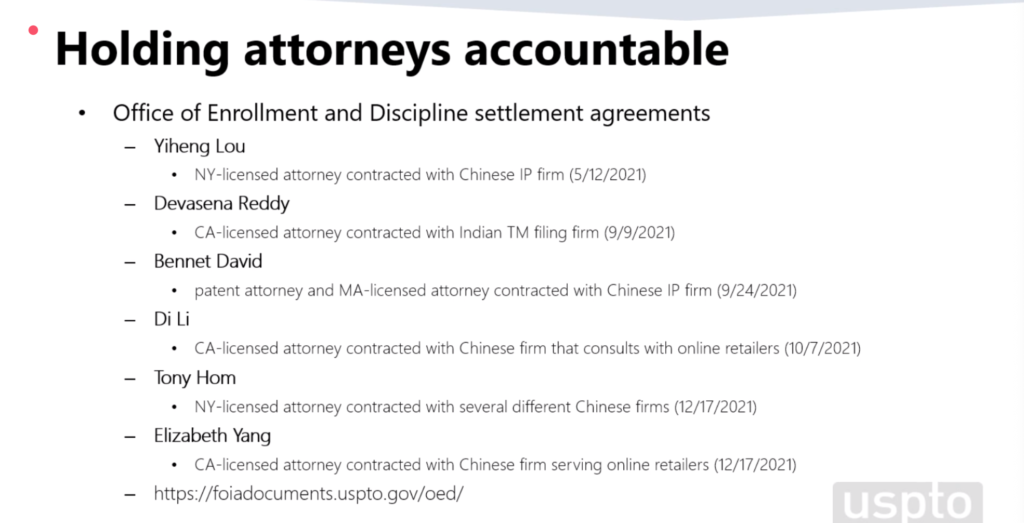
The USPTO also addressed its new administrative sanctions process to investigate improper trademark-related submissions. Under this process, when a submission appears to violate the Trademark Rules of Practice or the USPTO website’s Terms of Use, the USPTO will issue administrative orders that may result in sanctions being imposed. Sanctions may include:
- Striking submissions
- Precluding parties from appearing before the USPTO
- Terminating USPTO.gov accounts
- Terminating proceedings
- Referring practitioners to the Office of Enrollment and Discipline